 |
|
 |
2023
December
31
|
Old Year's Day
The last day of 2023 finds us doing surprisingly well, except for Melody's fracture, from
which we hope she will recover quickly. She is at The Oaks for nursing care and physical therapy.
Tonight, we will see the new year in together with
a kiss, for the 48th time, in an unbroken tradition starting in 1977.
Tonight, because of visiting hours, we will
celebrate at 7 p.m., which is midnight Greenwich Mean Time (UTC for the purists).
We did the same in 2017 (at The Oaks) and 2019 (at the hospital);
otherwise, we of course celebrate at local midnight.
This year my second career, at FormFree, kept me surprisingly busy, and, looking back,
I see that I haven't been to Deerlick Astronomy Village at all in 2023, 2022, or 2021!
Nor did I make it to the Lawrenceville Hamfest.
COVID played a large role in discouraging me, but that's largely over now.
But I did have a large role in
creating a piece of software that may well revolutionize some banking practices
all over the country.
And as soon as the weather clears up and warms up,
and circumstances permit, I will go to Deerlick!
Permanent link to this entry


|
2023
December
29
|
Melody's progress report
As her broken pelvis continues to heal, today Melody moved to The Oaks,
a convalescent facility, for a few days of nursing care and physical therapy.
On the 31st we will see the new year in at 00:00 Greenwich Mean Time,
which is 7 p.m. here, because visiting hours end at 8:30. We saw 2017 and 2019 in the same way, because she was
at The Oaks for the first one and in the hospital for the second one.
We have seen the new year in together every year starting with 1977.
Permanent link to this entry


|
2023
December
28
|
The question that makes people's heads explode
[Slightly revised.]
Here's a question you can ask people that sometimes almost makes their heads explode:
"Why do you believe that?"
I'm not talking about religion — I'm talking about any unconfirmed claim about anything.
Some people can't answer. They don't think they need a reason. Words are running around in their head, so they utter them. They are actively afraid of hearing different words. "It sounds right to me" is all they can say.
People on that level may get angry at even the friendliest request for explanation
or elaboration. All they have are the words, which are like a team slogan,
not a considered opinion. They may not even be able to tell you what the slogan means.
They think that if you ask them to tell you more,
you're picking an argument.
Next up are those who cite one authority, not a very good one. "I saw it on TV." "Ya gotta watch this video." "My sister's best friend said so, and she don't lie." The last of these was someone's exact words to me defending an e-mail scam.
Even "I saw it in a book" is a step up from that, because books are easier to trace to their sources.
See what I wrote a while back about oral versus
literate approaches to communication.
It's a bigger step up when people start realizing the quality of the authority matters. "He's an M.D." "That newspaper is fairly respected." And so on. But still only one authority.
But an educated person knows where information comes from. Not just what one authority says, but why that person is an authority, whether other experts agree, and where they claim to get their knowledge — historical records,
scientific experiments, and so forth. I run into otherwise well-educated people who don't realize
there are historical records from ancient and medieval times (I've held handwritten books from the 1300s in my own
hands, and read them); others who don't realize that, for instance,
treatments for diseases are carefully tested on large numbers of patients before being put on the market.
Some less-educated people don't realize experts even exist — that people walk among us
who know the details of foreign languages, or law, politics, history, or science, and aren't just quoting
their dim memory of textbooks. This is a common illusion in small towns where most people never
see anyone who is highly educated, or don't know what it implies when they do.
For some, all education is handed down through textbooks, and it's a mystery
where textbooks come from.
If you get nothing else out of your college education, I hope you get some
awareness of where knowledge comes from, that it's not just people making pronouncements,
that facts are not just words in people's mouths, that claims can be questioned, and,
most importantly, that when you question, you need to sincerely want answers.
Another head-exploder is "If that were not true, would you want to know?"
See this, from several years ago.
A draft of the above was well received on Facebook. Meanwhile, as this is uploaded on the
evening of the 27th, Melody is still in the hospital, and we're taking things slowly, because the
more the bones can knit before she tries to move around, the better off she'll be.
I appreciate more than 100 messages of good wishes and want everyone to understand that I am not
in a position to answer all of them.
Permanent link to this entry


|
2023
December
27
|
Have you ever seen this linoleum pattern?

Have you ever seen this linoleum pattern?
It apparently dates from the 1930s and may have come from Sears, Roebuck.
The largest colored flakes are about 5/8 inch long.
As far as I can tell, it is not a print, but rather, the colored flakes are
mixed randomly in the gray material, so the pattern does not repeat.
This was on the floor and also the built-in kitchen table of the farmhouse in Jenkins County
that my grandparents Covington built in the 1930s.
Separately, Melody thinks she once saw it in an old house in Tucker, Georgia.
On Saturday I surprised my sister by giving her two computer mouse pads
(printed by Vistaprint) that had this pattern on them, realistic in color and size.
Back in 1976, when my grandmother died, I realized that this pattern would bring back
memories of my childhood, and I took a good Kodachrome slide of it with my
Mamiya/Sekor 1000 DTL. Fast-forward 47 years, and with digital technology, I was able
to edit it and get it printed on mouse pads at low cost. Of course they can also
be used as pads for other things.
Our good friend Elizabeth Reed Smith identified it as Armstrong "Granada Gray" 5004,
listed on page 65 of this 1955 catalogue.
Thanks and kudos!
Permanent link to this entry


|
2023
December
26
|
Christmas, with a complication
Let me start by telling you what threw a complication into our Christmas.
On Dec. 25, at a gathering of her family in Loganville, Melody tripped, fell,
and broke something. Fortunately, her aunt, the recently retired head of EMS
for Upson County, took charge, and we persuaded the Loganville ambulance to take
her to Piedmont Hospital in Athens.
There we ascertained that she has a pubic ramus fracture, a type of hip fracture
that is self-stabilizing and heals with rest. So she will have complete bed rest
for several days and gradually resume moving around, using crutches, a walker, or
a wheelchair to avoid putting weight on her right leg for about six weeks. In the meantime, it is very
painful when she moves it the wrong way.
So I'm back to taking care of her the way I did after the hip operations, except that
this recovery won't take as along. Fortunately, I can work from home much of the time.
She will be in the hospital several days.
Also fortunately, Sharon is much healthier and more active than any time for several
years. The nerve damage is gradually retreating and her muscles are getting back to
normal functionality. This weekend she managed to enjoy a gathering of my sister's
family on Saturday (Dec. 23), then get to church with us on Sunday, and then go to the gathering
on Monday — in fact she contributed some delicious homemade ricotta dip and other
delicacies to both gatherings.
And Christmas did come. On Christmas Eve, the traditional lasagna was made,
this time by two cooks.

And we exchanged presents
around the Christmas tree. We hadn't intended to do anything big because major gifts
had already been given — I gave Melody a Scott Pope painting, and we gave Sharon
a gym membership and a skin care program.

The big thing on Christmas Eve is that Melody and I gave each other a musical keyboard.
It's for learning about music, not performing. I want to regain what little I once knew
about playing the piano, and Melody is working through a music theory course
(no matter how much you like the guitar, you need a keyboard to see and do a lot
of important things quickly).
I'll write more about this later, but — a synthesized keyboard is very different
from a classical instrument. The reason is, a traditional piano has fixed specifications,
and composers and musicians challenge themselves to get the most out of it, playing with
all ten fingers, etc. But a synthesized keyboard is quite open-ended. Nobody tries to make
it do all that it can; that would be too much. You'll see very good performances in which
the musician sets up an auto-repeating accompaniment on the lower keys and then plays the
tune with just one hand, one note at a time. There's no reason you have to play it like a
piano. You can use it as a substitute for a flute or clarinet, which is musically much
simpler.
(And although it can sound like a grand piano, it is not a pianoforte — that is,
you can't play soft and loud notes mixed together, because loudness does not depend on how hard
you hit the keys. A small limitation, especially since we aren't all that interested in the
piano except as a tool for exploring music.)
Sharon and Melody surprised me with two very useful tools.
One is a mechanic's endoscope (borescope), a video camera device for looking down holes.
It will be extremely useful if I have to either work on electrical wiring inside a wall,
or look for a snake under furniture (that has happened!), and very useful for many
other things. I'll write more when I've tried it out. The other tool is a tire pump
that is powered by its own rechargeable lithium battery and is not a lot bigger than a
deck of cards. This would be a handy thing to keep in the car.
Melody's accident stopped me from spending time playing with my new toys.
But there was one other noteworthy thing.
All weekend and through Monday and Tuesday, it rained.
This rain gauge, emptied on the 24th,
read 4 inches on Tuesday evening (Dec. 26); at 4 a.m. the same day
we had had thunderstorms, and for several days the temperature was around 60 F.
I haven't emptied the rain gauge yet; I want to see how high it will get, because
the rain still hasn't stopped. Yet I did not encounter any street flooding.
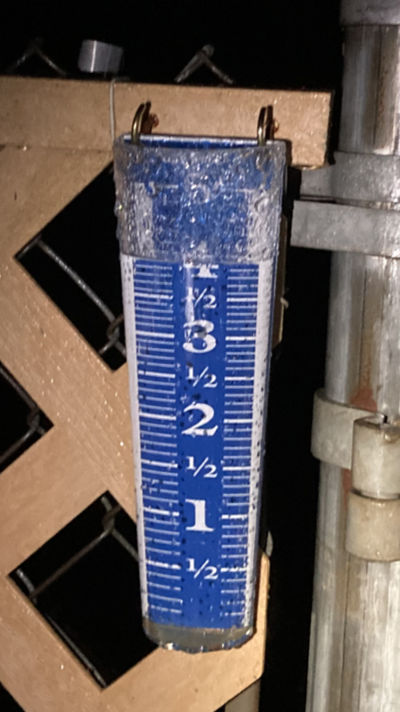
Permanent link to this entry


|
2023
December
24-25
|

Permanent link to this entry


|
2023
December
18
|
Holly the Dog, 2010?–2023

Sharon's dog Holly, who had been with us since 12 years ago this month, made her
sad final trip to the veterinarian today.
She had been diagnosed with a tumor above her teeth, originally thought to be
a dental problem, and was losing the ability to eat.
Surprisingly spry until the last, she was still able to take short walks
around the yard this morning, but the next few days portended a rapid decline.
Sharon got Holly from a dog rescue project in 2011, and Holly was Sharon's faithful
companion during the worst years of the peripheral
nerve disease that still limits Sharon's activities,
but, thankfully, is not as bad as it used to be.
When Holly realized Sharon was disabled, Holly's maternal instincts kicked in, and
from then on, Sharon was Holly's puppy, constantly tended and guarded.
That, I think, is why Holly was so loath to give up normal activities even though
severely ill.
Farewell, faithful helper.
Permanent link to this entry


|
2023
December
17
(Extra)
|
"AI Demonic"??!!
A heretofore respectable Christian magazine, Touchstone, is telling the world
that my profession, artificial intelligence, is "demonic." And so is a lot of other
technology.
In an article titled "AI Demonic" (Nov.-Dec. 2023, p. 29), "novelist, essayist, and poet"
Paul Kingsnorth delivers a remarkable display of ignorance.
After opining that digital technology is itself somehow supernaturally evil,
he says that in the past year we've seen "the birth of Artificial Intelligence.
Now it is here. Now everything really changes."
What, pray tell, was born this year, other than advertising hype for ChatGPT?
He tells us that "by November last year, ChatGPT had the theory of mind
of a nine-year-old." No, it didn't. It has the ability to talk like a nine-year-old
(and many other kinds of characters)
by imitating texts it was trained on.
Similarly, he refers to a transcript of ChatGPT yammering in imitation of sources
and says "the overwhelming impression ... is of some being struggling to be born,
some inhuman or beyond-human intelligence emerging..."
No, no, no. A machine that can retrieve and paraphrase other people’s words is no more conscious or demonic than a phonograph,
even when playing a horror-movie soundtrack. ChatGPT does not think for itself — it imitates people who were
thinking for themselves. It certainly does not have "theory of mind" nor is it about to be "more advanced than us."
It was imitating the writings of real people that were fed into it for training. (See also the entry below.)
There are people in the world who know how AI technology works. He should have consulted one.
He might then have found out how far these chatbots are from human minds and that there is no
known technical path toward making computers conscious.
There are indeed people whose fantasies and ambitions for AI strike me as irresponsible and ungodly.
But they are just fantasies and ambitions; they do not pertain to any technology that actually works.
Talking with such people is like being asked, "If pigs could fly, what color would their feathers be?"
Let's stick to the real world, and answer irresponsible proposals on their own merits, without
being gullible.
How much harm will I personally suffer because my fellow Christians have been told I'm summoning demons?
This is 2023, not 1423. But, somehow, actually knowing how AI works is viewed by the public
as a disqualification. They won't believe me when I tell them how machines work.
They'd rather believe it's witchcraft.
Permanent link to this entry
Chatbots can regurgitate their training data
When chatbots like ChatGPT came out, some linguists, including me, realized that many English
sentences are extremely rare, such that they would occur only once even in a very large training
set, and that when prompted for something that matches a rare input, the chatbot could
reply by reproducing the words of a single training source, not a combination of many.
Now it has been shown that chatbots can indeed regurgitate their training sources.
Researchers at Google figured out how to do it.
Newspaper coverage here;
scientific paper here
(Nasr et al., "Scalable extraction of training data from (production) language models.")
There was always a risk of regurgitation, but they devised some trick prompts that produce much
more of it than usual, allowing large amounts of training data to be extracted (and thereby showing
that it can pop up in what looks like original discourse from the chatbot).
Permanent link to this entry


|
2023
December
17
|
Where was the Epps Bridge (Athens, Georgia)?
The west side of Athens, Georgia, where I live, has streets and roads named
Epps Bridge Parkway, Epps Bridge Road, and Old Epps Bridge Road (the last of these
discontinuous). Where was this Epps Bridge?
I know that the Epps family were major property owners around here a century ago,
and one of them was a pioneer aviator. I am not trying to track down the whole
history, just the geography.
By comparing a map dated
1895,
a 1936
soil map,
aerial photos dated
1938
and
1951,
and the
1964 USGS topo map,
I've figured it out...
|

Click and click again to view enlarged.
|
| |
This is the 1938
ASCS (Agricultural Stabilization and Conservation Service) aerial photo of the area.
I thank my nephew Connor Paul for putting me on the trail of the ASCS maps.
In 1895, the Atlanta Highway did not exist, and the Epps Bridge Road was the main route
out of Athens to the southwest. To get to Bogart and Statham (and ultimately Atlanta),
you'd go down Epps Bridge Road to what is now the Timothy Road intersection (at Chestnut Grove
Church) and turn right. Where Timothy Road nowadays joins the Atlanta Highway, you'd be on the
road westward to Bogart.
Sycamore Drive was then part of the Epps Bridge Road. If you go down Sycamore Drive all the way
to the river, you're at the site of the bridge, and across from the river, it joined what is now
Old Epps Bridge Road, southbound. (The northbound leg of Old Epps Bridge Road from there is not
original.)
The Epps Bridge was still in use in 1938 but not in 1951. The Atlanta Highway, taking over its
function, apparently dates from very close to 1938, as it is not on a 1936 map.
I am not presenting this as complete historical research, just as the solution to one mystery.
I live somewhere on this map — I won't say where.
Permanent link to this entry


|
2023
December
16
|
Another interesting field in Cassiopeia
I had another astrophotography session on the evening of December 14
(while watching the Gemini meteors from a
"zero gravity chair").
Again I used the Askar 200-mm f/4 lens and Canon 60Da at ISO 800 with an
Orion SkyGlow filter, on my Losmandy GM811G with no guiding corrections.
Here's a stack of 50 2-minute exposures of the field of the star Navi:
|
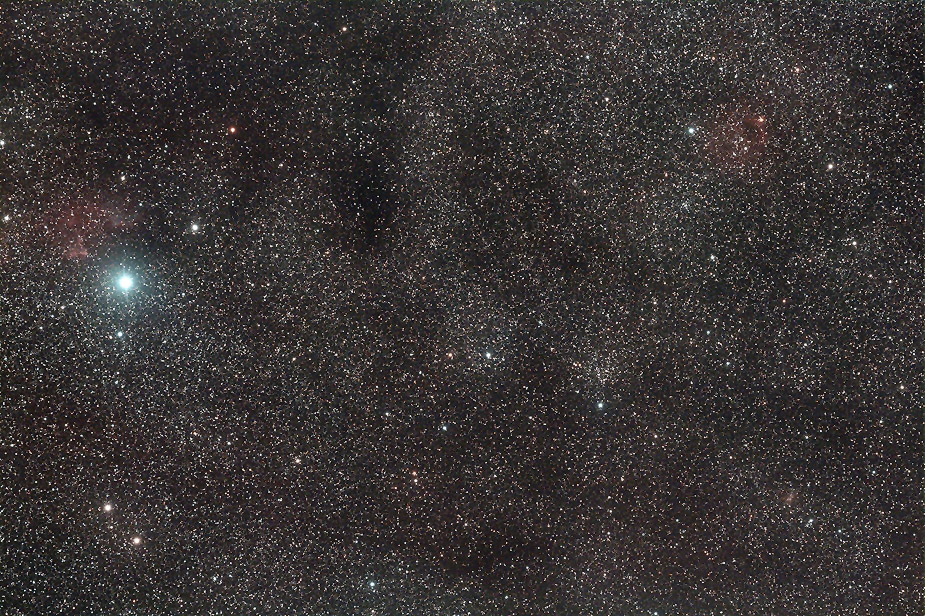
Click and click again to view enlarged
|
| |

Here you can see the nebula near Navi at the left, other nebulae elsewhere, star clouds in our own galaxy,
snake-like dark nebulae (dust clouds), and, at the lower right, IC 10, which is a distant galaxy
reddened by dust clouds in our own galaxy in front of it. Multiscale processing was applied to bring
out faint nebulosity here.
The story of how Navi got its name
is worth knowing. It is "Ivan" backward, the middle name of astronaut "Gus" Grissom.
He and the other two Apollo 1 astronauts managed to sneak portions of their own names
into a list of navigational stars. After they died in the tragic launchpad fire,
the names were made official. (Regor and Dnoces are the other two.)
Permanent link to this entry
Flaming Star Nebula and its field
I've photographed the Flaming Star Nebula and its environs before, but this may be
my best picture yet. Same equipment and processing as above, but only 22 images were
stacked, and no multiscale processing was done (thus the brightnesses of these nebulae
are depicted consistently across the picture).
|
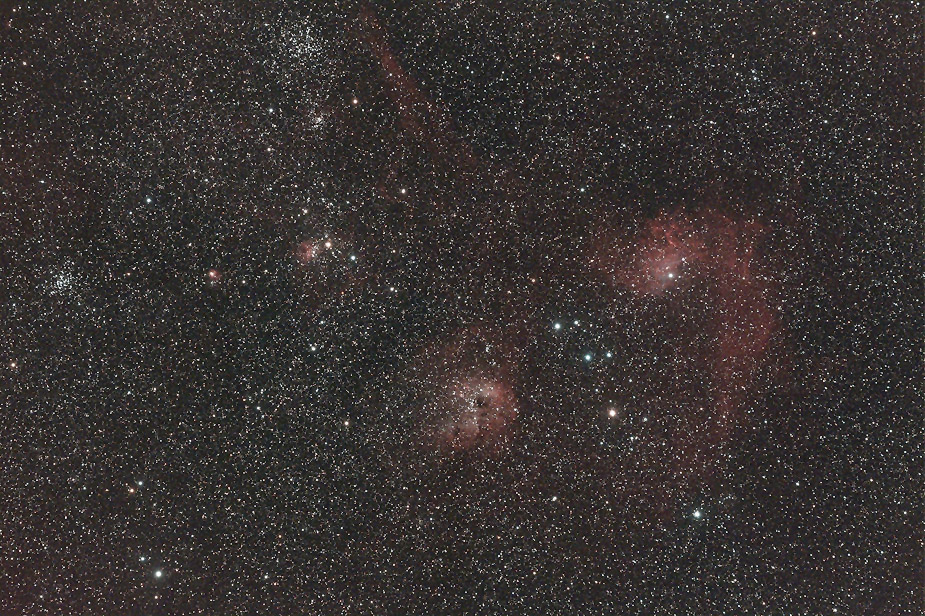
Click and click again to view enlarged
|
| |
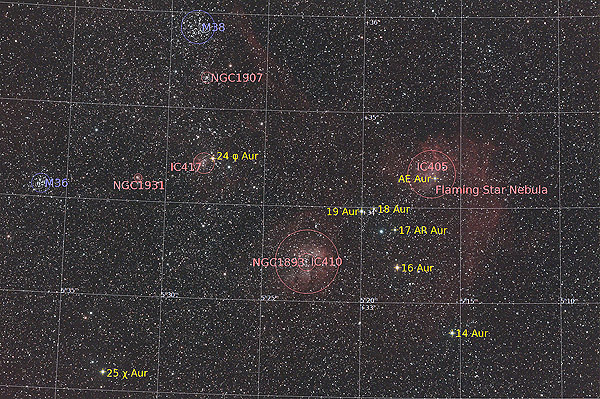
Permanent link to this entry


|
2023
December
13
|
Clusters and nebulae in Cassiopeia
The night of December 12 was clear, and I continued photographing nebulae...
Stack of 34 2-minute exposures, Askar 200-mm f/4 lens and Canon 60Da (ISO 800) on my GM811G mount,
Orion SkyGlow filter,
without guiding corrections. This is a rich field in Cassiopeia that I had not photographed
before.
|
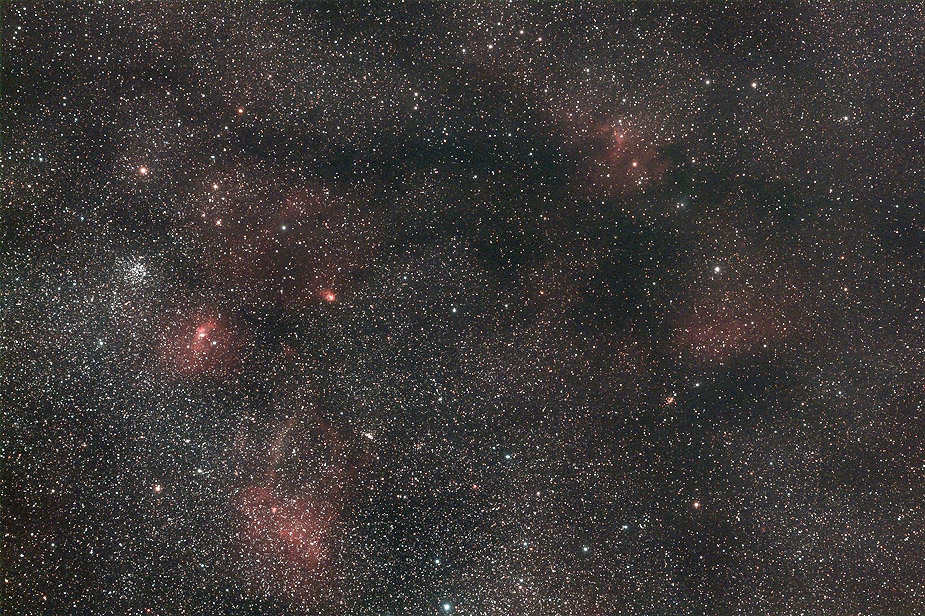
Click, then click again, to view larger.
|
| |
Reprocessed December 16 using some multiscale linear processing to enhance features on a scale
of 256 to 512 pixels, bringing out the faint red nebulae and the dark nebulae,
a technique I just learned from Vicent Peris, one of the developers of PixInsight.
Here are identifications of some of the objects:
|
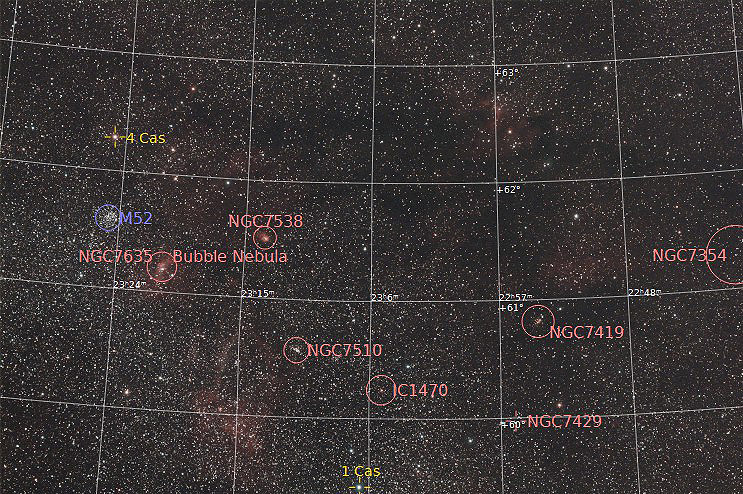
|
| |
Permanent link to this entry
Heart and Soul nebulae, in depth
Here is a better, longer exposure of the Heart and Soul Nebulae.
This is a stack of 70 (yes, 70) 2-minute exposures — more than necessary,
but I lost count and left the equipment running for a long time.
Same equipment as above. Enjoy.
|

|
| |
Permanent link to this entry


|
2023
December
10
|
M31 reprocessed and annotated
More fun with new PixInsight features
Here is my 2020 Deerlick image of M31
reprocessed with SPCC.
You can see that the colors are more accurate, especially the colors of the stars
(particularly a blue one to the left, and a reddish one to the lower left, closer in).
The real interest of color in an image like this is to see the yellow-tan dust in
the dusty parts of the galaxy and the blue starlight in the bright star-forming regions.
|
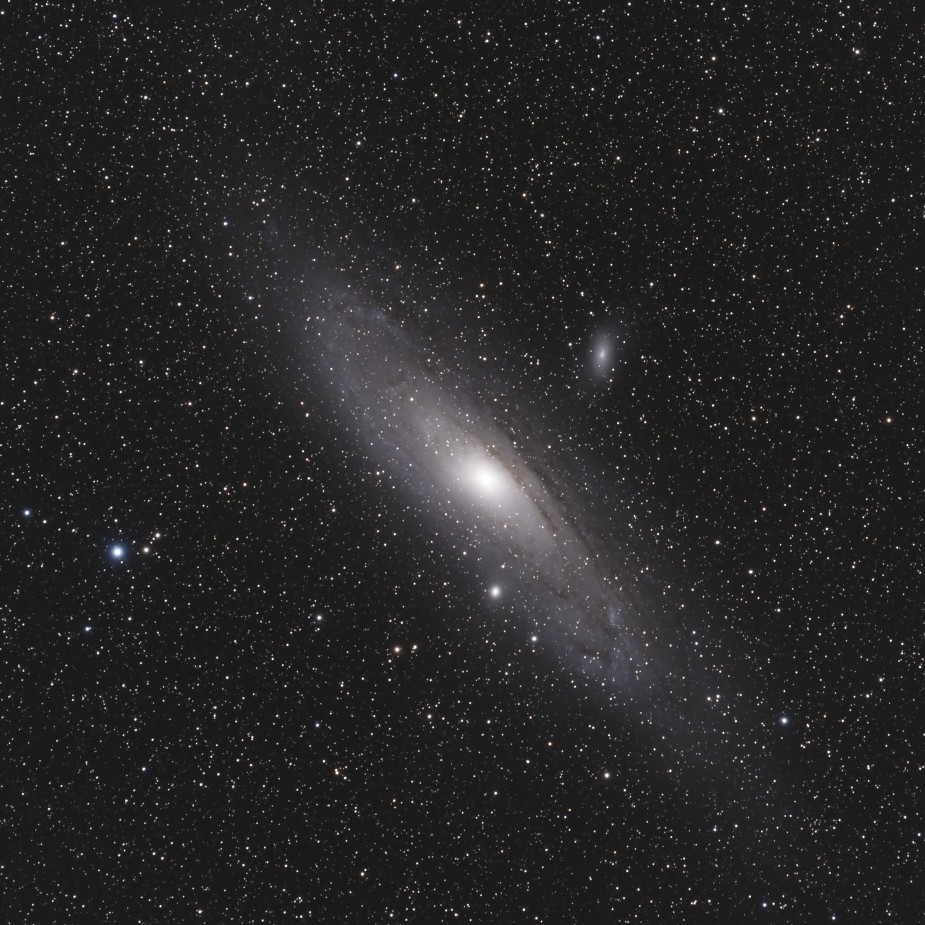
|
| |
But spectrophotometric color calibration is not the only thing we get by having PixInsight
solve the image (to determine its position, scale, etc.). It can annotate the image:
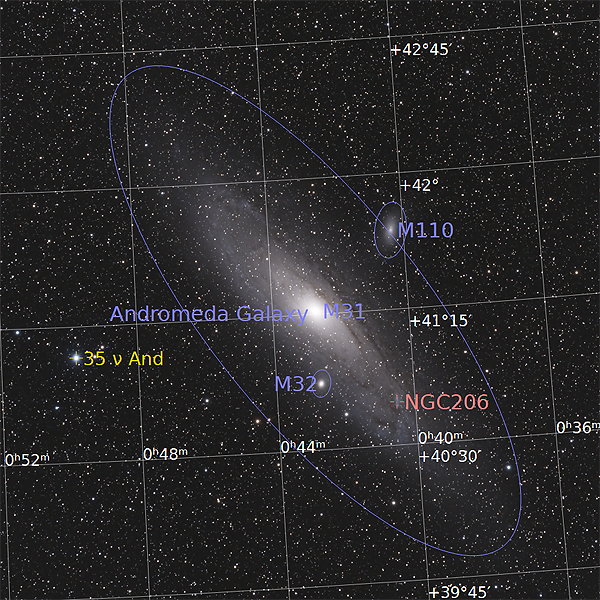
and even give us a finding chart showing where it is located in the sky:

All of this could be classed as data-informed astrophotography.
Gone is the laborious task of matching a picture up to a star map.
Basic catalog information about celestial objects is put to use from before we
take the picture, all the way through processing and final presentation.
Permanent link to this entry


|
2023
December
9
|
Spectrophotometric color calibration in PixInsight
Here is my stack of 58 2-minute exposures of NGC 7331 from last month,
processed a different way...
|
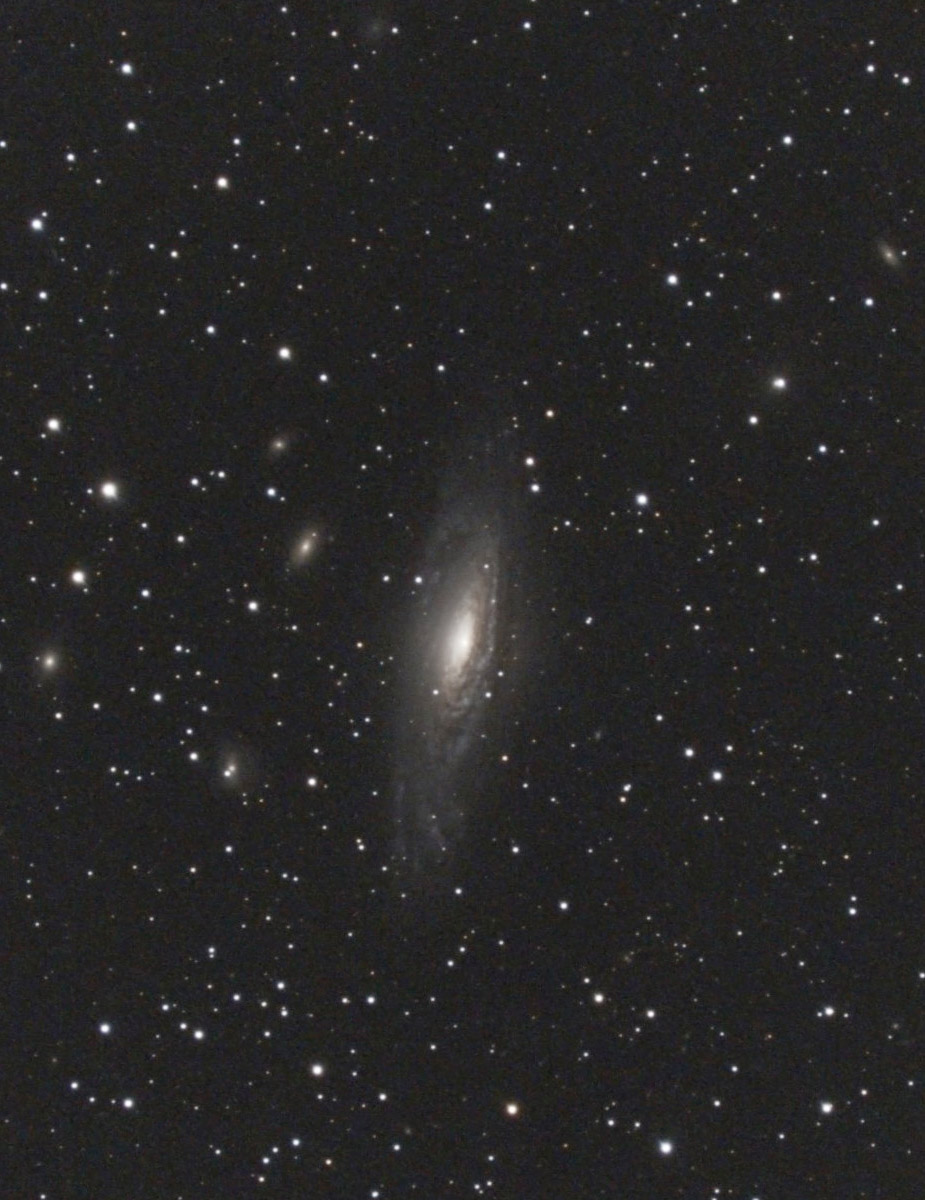
|
| |
Compare it, if you will, with the previous version.
The colors are a little purer here.
This is still a color image; you can see some yellow or tan in the dusty
central region of the galaxy, and maybe some blue in the brightest star-forming regions.
As you know,
adjusting the color of an astronomical image is problematic,
and until now I have been using a method that
simply assumes that the sky background should be neutral
(not a completely true assumption in town).
The new method,
Spectrophotometric
Color Calibration (SPCC),
actually uses data from the Gaia space telescope to determine what color the stars
should be.
To do this, it has to identify the stars, which means it has to plate-solve the image,
something PixInsight has been good at for a long time (Scripts, Image Solver; you have to enter the
focal length and pixel size, and say what object you've photographed, either by coordinates or by
catalog designation).
SPCC then performs a very sophisticated correction, matching up the measured spectra of the stars
(with photometry at all visible wavelengths) to the expected sensitivity of your sensor with its RGB filters.
Admittedly I used the filter settings for the Canon 60D, not 60Da.
Later I tried again using a set of filter settings called "Canon Full Spectrum" that are not
really full-spectrum — they look very much like what I know about the 60Da.
It made no visible difference in the results, but I am inquiring.
I had a momentary qualm about SPCC because it's combining the results of my observations with
someone else's (Gaia's). But it is surely better than just relying on our own recollection
of what things ought to look like.
In fact, the PixInsight team
argues cogently
that images calibrated this way are more authentic than those with arbitrary manual
color adjustments.
One more handy note:
In SPCC, background neutralization is optional. If you turn it off, you can find out what color your sky
background really is. Mine, seen with this camera, is dark cyan, which is reasonable in a town with
mostly white (LED) streetlights. I'm working on a way to take a spectrum of the sky background
(probably using a Project STAR spectrometer) to find out more about whether nebula filters will help
cut it out. Stay tuned for more developments.
The case of the green galaxy:
Please reread this entry from 2 years ago,
which I have just rewritten.
Permanent link to this entry


|
2023
December
6
|
California Nebula (NGC 1499)
Two nights ago (December 4), I accidentally repeated an astrophotography project
from two years ago — I'm not sure if this one is better.
The optics were the same, Askar 200/4 lens at f/4 and Orion SkyGlow filter.
This time the camera was the Canon 60Da at ISO 800 and the mount was the Losmandy GM811G
with no guiding corrections. This is a stack of 51 rather than 20 2-minute exposures
and is presented at slightly lower magnification.
|
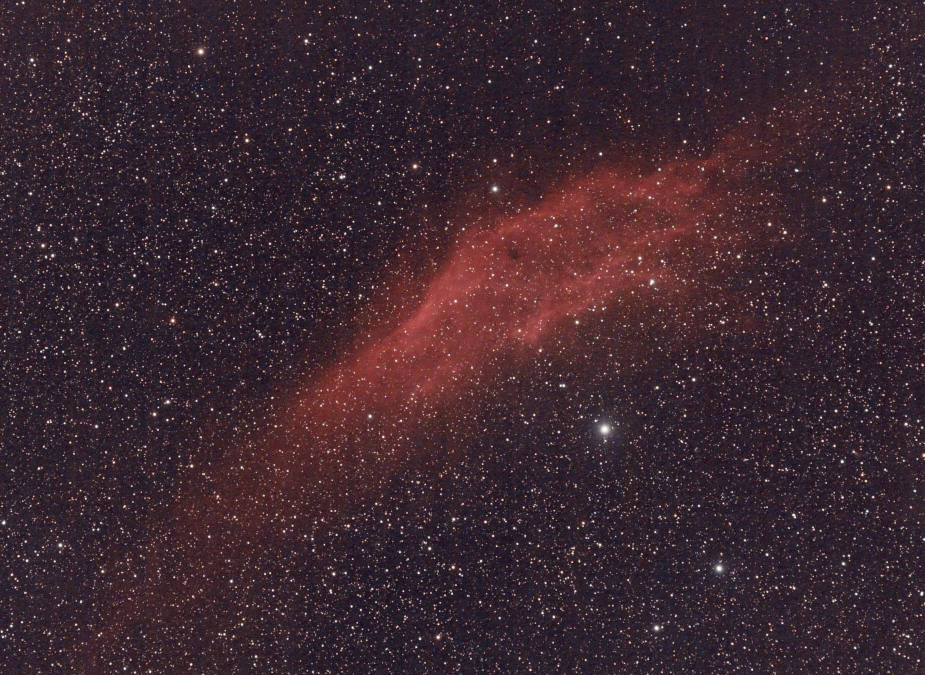
|
| |
A few things were different about my workflow. I used the camera at ISO 800 rather than 640,
having determined that that seems to be better (last month).
I was using a brand-new release of PixInsight (which happens every couple of months), with
the Weighted Batch Preprocessing (WBPP) script.
"Walking noise:"
The tracking was fine during each frame, but over the whole sequence, there was a slight
continuous shift due to flexure, which caused a small amount of what is called "walking noise,"
noise with a streaky texture, in the resulting image, which was stacked with the stars aligned.
The actual shift was only a few pixels total, not nearly as long as the streaks seem to be.
Here's what it looks like:
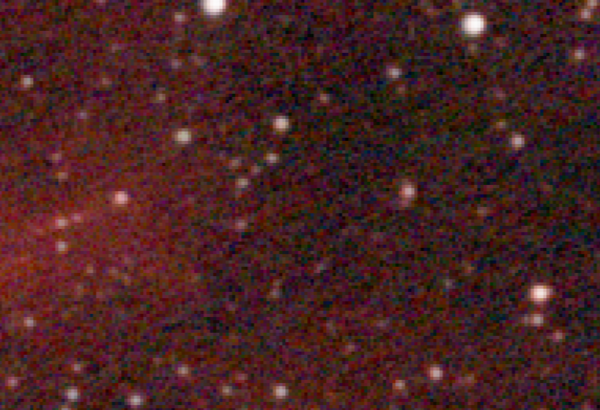
The cure for walking noise is dithering, periodically re-aiming the camera slightly
differently than before, so that any fixed-pattern noise in the camera frequently gets shifted
relative to the stars. This can be done manually, but it's much easier to automate it under
computer control, which requires a guidescope. In this case I don't think the walking noise
shows up in the finished picture. TGVDenoise (in PixInsight) got rid of it.
Permanent link to this entry
Heart and Soul Nebulae (IC 1805, IC 1848)
One of these nebulae obviously looks like a heart; I don't know what a soul is supposed
to look like. Between them is the star cluster NGC 1027.
|
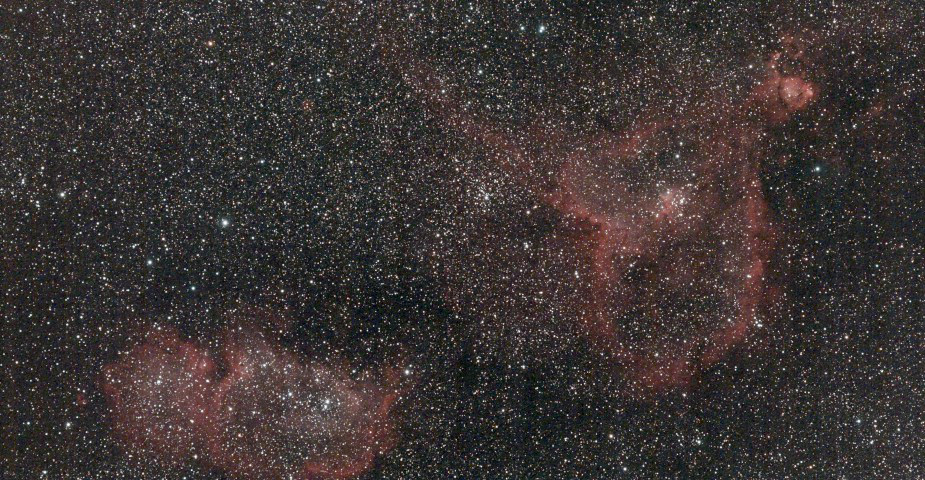
|
| |
(Reprocessed December 20.) Here is the same picture with annotations:
|
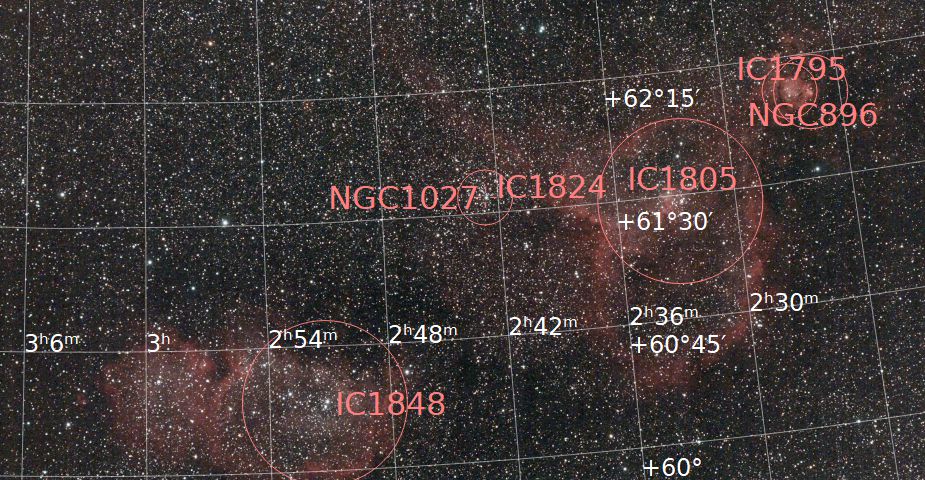
|
| |
This was my real target for the night; stack of 46 2-minute exposures. I haven't
photographed these nebulae before. They were behind a tree when I started the session,
which led me to do the California Nebula first.
Permanent link to this entry
Keeping up with PixInsight:
The long file path warning
When I started to process those pictures, PixInsight claimed the file path for the output was
too long. I hadn't seen this warning before, but I also hadn't used quite the set of directories
that I was using. Here's what I saw:

Fortunately, it is fairly easy to set Windows 10 or 11 to allow long paths. If you are familiar with
Windows administration, the following instructions will suffice:
- In Windows Professional or Enterprise, use gpedit.msc and find and enable the option
Computer Configuration, Administrative Templates, System, Filesystem, Enable Win32 long paths.
- In Windows Home, use regedit to set
Computer, HKEY_LOCAL_MACHINE, SYSTEM, Control, CurrentControlSet, FileSystem, LongPathsEnabled (DWORD) = 1.
For more detailed instructions see this. And note two more things:
[Update:] There are some unanswered questions about this.
The long path warning sometimes comes up when not called for.
Apparently, to satisfy PixInsight on my Windows 11 Pro machine, I had to do the registry setting
as well as the group policy (which does not make the registry setting).
I've put in a support request.
After you make this setting, not all software will handle long file paths, but PixInsight will.
You will still get the PixInsight long file path warning if you select a network path for output.
That is not a reasonable place to put output anyhow.
Permanent link to this entry
Keeping up with PixInsight:
Mismatched geometry when DSLR senses rotation
Even when "Auto rotate" is turned off in your DSLR, the raw files are likely to contain information
about the camera position. This can cause some of your frames of an object not to match others,
and Windows will show this when they are displayed as icons:
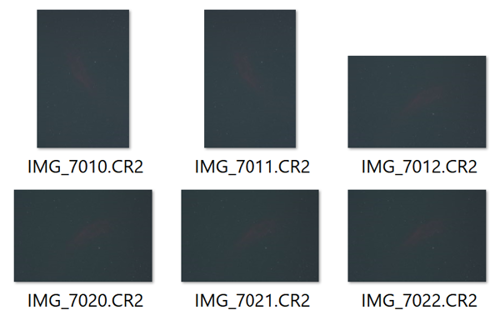
This can make PixInsight complain about "incompatible image geometry" with messages such as
"Expecting 4000×6000 pixels, found 6000×4000" or the like.
The cure is to tell PixInsight to ignore the rotation data from the camera
(and I don't know why that isn't the default). In Format Explorer,
double-click on RAW and check "No Image Flip":
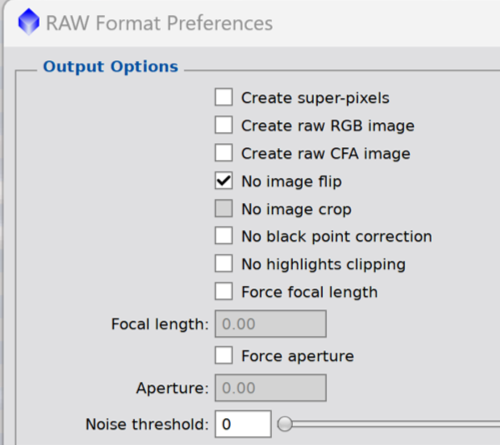
And that's all you need. Of course, if you are using master dark files that were made earlier
with that selection not made, you may need to re-create them, if you're unlucky about which
way they ended up.
Permanent link to this entry


|
2023
December
3
|
Pronunciation of Gloria in excelsis Deo
A musician asked me what I, as a linguist and Latin scholar, can recommend about how to
pronounce Gloria in excelsis Deo, and in particular excelsis,
since all major methods of pronouncing Latin agree about the other three words.
(But I have heard German choirs put Deo through a High German
vowel shift, making it almost into Dio; examples below.
I think this is simply an error, not authentic Latin as once spoken in Germany,
since they're treating a Latin short E like a German long E.
But I could be wrong.)
I'll be glad to answer, with two disclaimers.
(a) I'm talking about Latin, not about musical technique. I know that in choral singing,
sometimes you need a deliberate mispronunciation to compensate for the blurring effect of
combining many voices. Pronouncing S as Z or K as G are examples of this.
That's not what I'm addressing here. I'm talking about pronunciation in spoken Latin.
(But see last paragraph.)
(b) Latin is a real language, and some people (including myself) know the details of it.
It is not a lost language passed along in fragments by people who don't actually know it.
Nor is it a fictional language that composers or musicians are free to alter.
All this should be obvious, but I sometimes get arguments from people who don't realize it!
One more point. The last syllable of excelsis definitely rhymes with "cease," not "sis."
In Latin, there are two different -is suffixes, with different vowel lengths,
pronounced differently. The one that rhymes with "sis" would be ungrammatical here.
(With vowel lengths marked, they are -īs, 2nd declension ablative plural, and -ĭs, third declension nominative singular.)
Now then. The dispute is how to pronounce the excel- part. Latin has been in use for
well over 2000 years and has been pronounced
many different ways at different times and places.
Here are the pronunciations of excelsis that I'm acquainted with:
| (1) |
eks-kell-seese
|
(Ancient Roman, pre-Christian)
|
| (2) |
eks-tsell-seese
|
(North European, heard in Germany and Scandinavia)
|
| (3) |
eks-chell-seese
|
(Church Latin, Italy)
|
| (4) |
ek-shell-seese
|
(Church Latin, newer? Closer to modern Italian)
|
| (5) |
ek-sell-seese
|
(France or influenced by English?)
|
Now how do we choose? I don't consider a Latin pronunciation "correct" unless it has actually
been used by people communicating in Latin (not just performing songs).
After all, if somebody told you excelsis was pronounced "blah," that's the kind of
evidence you'd look for: who pronounced it that way, where and when?
With all that in mind, all five of those pronunciations have been used by Latin speakers,
classically or postclassically. Which ones do we hear in good musical performances today?
I'm going to take a poll by looking up, on YouTube, a lot of performances of
"Angels We Have Heard On High" and its French and German counterparts, and the British
arrangement of "Angels From the Realms of Glory" that uses the same refrain. Here's a
list of which pronunciations
I heard:
Clearly, (3) and (4) predominate.
They are very hard to tell apart, which of course is why they both exist.
Although trained in phonetics, I don't claim to have a "golden ear," and some of you may disagree
with my classification of a few of these. But (3) and (4) are the clear winners.
Personally I have a preference for (3), which is a little more of a spelling pronunciation — does
not follow Latin quite as far into modern Italian — and I think is an older Church Latin usage,
though I'm not entirely sure.
[Added:] A correspondent points out that singers and choir directors like to
avoid excessive sibilance (S sounds), and that's a reason for preferring (4) over (3), or
even changing (3) to (4) independently for musical effect, as well as going even further
("egg-zhell...").
Permanent link to this entry


|
| |

|
|
|
This is a private web page,
not hosted or sponsored by the University of Georgia.
Copyright 2023 Michael A. Covington.
Caching by search engines is permitted.
To go to the latest entry every day, bookmark
https://www.covingtoninnovations.com/michael/blog/Default.asp
and if you get the previous month, tell your browser to refresh.
Portrait at top of page by Sharon Covington.
This web site has never collected personal information
and is not affected by GDPR.
Google Ads may use cookies to manage the rotation of ads,
but those cookies are not made available to Covington Innovations.
No personal information is collected or stored by Covington Innovations, and never has been.
This web site is based and served entirely in the United States.
In compliance with U.S. FTC guidelines,
I am glad to point out that unless explicitly
indicated, I do not receive substantial payments, free merchandise, or other remuneration
for reviewing or mentioning products on this web site.
Any remuneration valued at more than about $10 will always be mentioned here,
and in any case my writing about products and dealers is always truthful.
Reviewed
products are usually things I purchased for my own use, or occasionally items
lent to me briefly by manufacturers and described as such.
I am no longer an Amazon Associate, and links to Amazon
no longer pay me a commission for purchases,
even if they still have my code in them.
|
|




























